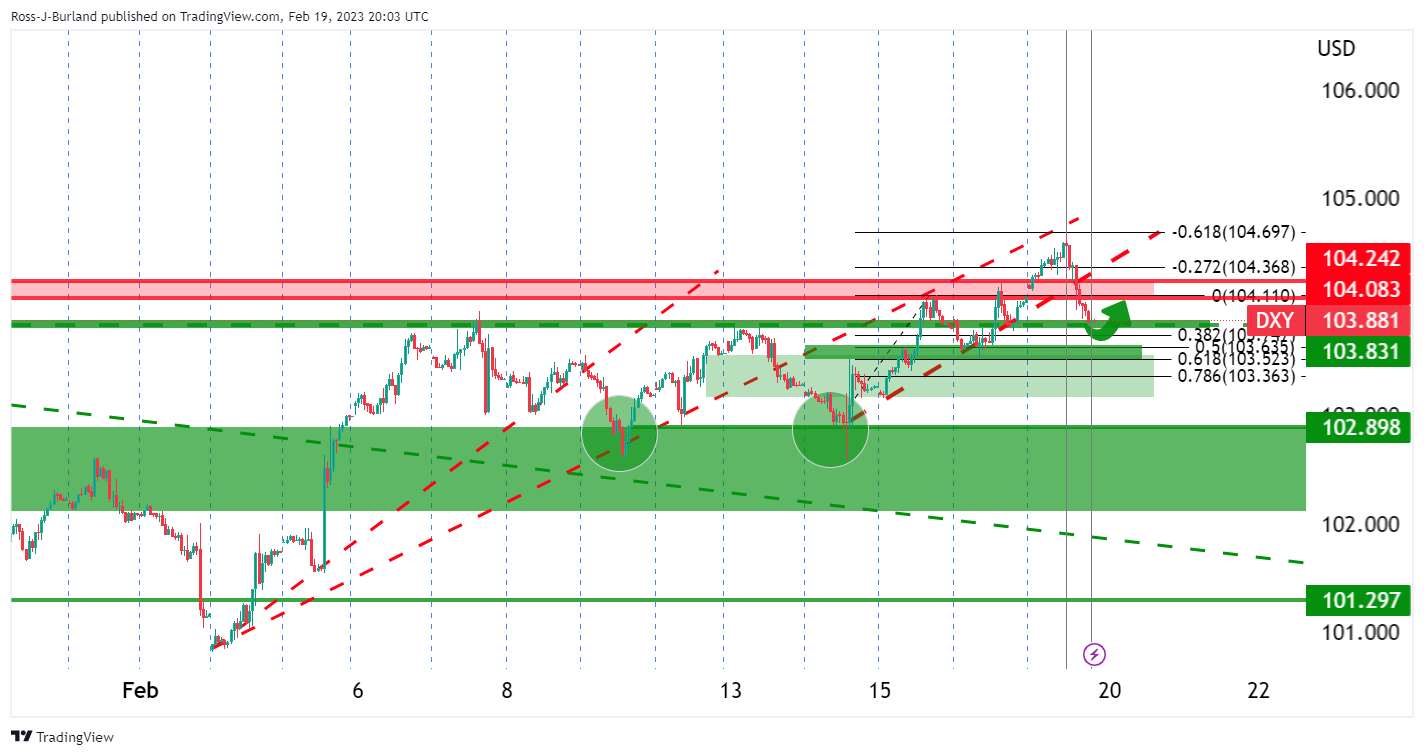- Analytics
- News and Tools
- Market News
CFD Markets News and Forecasts — 19-02-2023
Early Monday morning in Asia, Japan criticises North Korea’s ballistic missile testing as the hermit kingdom fired two such missiles.
While giving the updates on North Korea’s missile testing, Japan's Defense Ministry says North Korea fired 2 ballistic missiles on Monday morning, per Jiji News.
Japan’s NHK added that all North Korean missiles appear to have landed outside Japan's EEZ.
On the same line, North Korean leader Kim Jong Un's sister, Kim Yo Jong, said on Monday whether to use the Pacific Ocean as its "shooting range" depends on the United States, after firing what appears to be yet another ballistic missile off its east coast, reported Reuters.
Market sentiment weakens
Although geopolitical fears from North Korea aren’t new, the same joins the US-China tussles to weigh on the sentiment amid a sluggish start to the week, amid the US and Canadian holiday. With this, the US Dollar Index (DXY) reverses the previous day’s pullback from a multi-day top and weighs on the EUR/USD.
Also read: EUR/USD stays defensive around 1.0700 ahead of Eurozone PMIs, Fed Minutes
- USD/CHF has witnessed bids around 0.9240, supported by a recovery in the US Dollar Index.
- The Swiss Franc asset is testing the breakout of the downward-sloping trendline plotted from 0.9600.
- A bullish momentum will be triggered if the RSI (14) manages to reclaim the 60.00-80.00 range.
The USD/CHF pair has sensed a buying interest after a vertical correction below 0.9240 in the early Tokyo session. The Swiss Franc asset has picked demand as the market mood is getting nervous after a warning signal from the United States to China in case it decides to provide lethal support to Russia in its invasion of Ukraine.
The US Dollar Index (DXY) has rebounded to near 103.63 and is looking to extend its recovery as the risk appetite of the market participants is fading away. S&P500 futures are demonstrating more losses, portraying a risk aversion theme. This week, the release of the US Gross Domestic Product (GDP) data will remain in the spotlight.
USD/CHF is testing the breakout of the downward-sloping trendline placed from November 21 high around 0.9600 on a four-hour scale. Usually, a test of a trendline breakout with less velocity indicates the strength of bulls and prepares a platform for a confident upside move ahead.
Also, the 200-period Exponential Moving Average (EMA) at 0.9243 is providing a cushion to the US Dollar.
Meanwhile, the Relative Strength Index (RSI) (14) has failed to sustain in the bullish range of 60.00-80.00. A bullish momentum will be triggered if the momentum oscillator manages to reclaim the 60.00-80.00 range.
For a fresh upside, the Swiss Franc asset needs to deliver a confident break above February 6 high of around 0.9290, which will drive the asset towards January 12 high at 0.9363 followed by January 6 high at 0.9410.
In an alternate scenario, a breakdown below February 9 low at 0.9161 will drag the asset toward the round-level support at 0.9100. A slippage below the latter will drag the asset toward February low at 0.9051.
USD/CHF four-hour chart
-638124465358948994.png)
- WTI holds lower grounds near two-week bottom, prints six-day downtrend.
- Sustained trading below key DMAs, trend line join bearish MACD signal to favor sellers.
- 10-week-old horizontal support lures bears unless the Oil price remains below 100-DMA.
WTI crude oil remains depressed near $76.50 as it fades the late Friday’s bounce off 10-week low during early Monday in Asia. In doing so, the black gold remains below the converngence of the 21-DMA and the 50-DMA, as well as the downward-sloping resistance line from November and the 100-DMA.
Not only the sustained trading below the aforementioned key technical indicators but the bearish MACD signals also keep the WTI sellers hopeful.
That said, the previous day’s bottom surrounding $75.30 lures WTI bears at the latest, a break of which could quickly drag the Oil price towards a horizontal are comprising multiple levels marked since early December, near $73.00-72.70.
In a case where the black gold drops below $72.70, the late 2022 bottom surrounding $70.30 and the $70.00 psychological magnet will be in the spotlight.
Alternatively, recovery moves will initially have to cross the 50-DMA and 21-DMA convergence surrounding $78.10 to convince short-term WTI buyers.
Following that, the aforementioned multi-day-old resistance line near $79.00 and the 100-DMA hurdle surrounding $80.70 could challenge the WTI bulls.
Should the energy benchmark rises past $80.70, January’s high near $82.70 and the last December’s peak of around $83.30 could act as the last defense of the Oil bears.
WTI: Daily chart

Trend: Further downside expected
- EUR/USD fades bounce off six-week low amid sluggish markets.
- US holiday, light calendar on Monday restrict immediate moves.
- ECB vs. Fed battle intensifies ahead of FOMC Minutes, preliminary PMIs for February.
- Geopolitical headlines, hawkish central banks weigh on sentiment and underpin US Dollar strength.
EUR/USD retreats from the intraday high surrounding the 1.0700 threshold as traders struggle for clear directions during Monday’s initial Asian session. The market’s inaction could be linked to the holidays in the US and Canada, as well as a light calendar elsewhere. Even so, geopolitical conditions surrounding China and Russia join the recently hawkish Federal Reserve (Fed) bias, versus the doubts about the European Central Bank’s (ECB) future moves, to probe the pair buyers.
On Friday, ECB policymaker Francois Villeroy de Galhau said, "We will keep rates high as long as necessary; we must be careful not to declare victory too quickly." On the same line were comments from ECB Governing Council member Isabel Schnabel who told Bloomberg that another 50 basis points (bps) rate hike in March will be needed under virtually all scenarios.
In addition to the hawkish ECB comments, the US Dollar’s corrective pullback also allowed the EUR/USD pair to portray a bounce off the six-week low the previous day.
However, the firmer prints of the US Consumer Price Index (CPI) and Retail Sales followed the previously flashed upbeat readings of employment and output data and propelled the odds of the US economy witnessing more inflation ahead. The same joins hawkish Federal Reserve comments to underpin the firmer US Treasury bond yields and the US Dollar to exert downside pressure on the EUR/USD price.
As per the latest Federal Reserve (Fed) talks, Fed Governor Michelle Bowman said, “We are seeing a lot of inconsistent data in economic conditions,” as reported by Reuters. On the contrary, Richmond Fed President Thomas Barkin said that they are seeing some progress on inflation with demand normalizing, as reported by Reuters.
Elsewhere, the US-China tensions are back on the table as the latest meeting between US Secretary of State Antony Blinken and China's top diplomat Wang Yi seemed to have failed in restoring the US-China ties. The reason could be linked to a Chinese diplomat’s comments saying that the US must change course and repair the damage done to Sino-US ties by indiscriminate use of force. On the same line, US ambassador to the United Nations, Ambassador Linda Thomas-Greenfield, said Sunday that China would cross a “red line” if the country decided to provide lethal military aid to Russia for its invasion of Ukraine.
Amid these plays, the US 10-year Treasury bond yields rose to the highest levels since early November while the equity benchmarks were mostly in the red, which in turn weighed on the S&P 500 Future by the press time. That said, the US Dollar Index (DXY) marked the third consecutive weekly gain.
Looking ahead, the risk-off mood may exert downside pressure on the EUR/USD pair amid a likely sluggish day. That said, major attention will be given to the first readings of the UK’s February month PMIs and join the monetary policy meeting minutes by the Federal Reserve (Fed), up for publishing on Wednesday. Also important will be Thursday’s second reading of the US fourth quarter (Q4) Gross Domestic Product, to direct immediate EUR/USD moves.
Technical analysis
A clear downside break of a three-month-old ascending trend line, now immediate resistance around 1.0730, keeps EUR/USD bears hopeful.
- USD/CAD is attempting a recovery move after building a cushion around 1.3480 as investors are turning risk-averse.
- The Loonie has sensed a buying interest to near 1.3470, the region where the asset delivered a breakout.
- Canada’s core inflation is seen higher at 5.5% against 5.4% released earlier.
The USD/CAD pair has attempted a rebound after building a cushion around 1.3470 in the early Asian session. The Loonie asset is looking to extend its recovery as the risk aversion theme is gaining traction after a warning from the United States to China for providing lethal support to Russia against Ukraine.
Investors should brace for volatility as the US markets will remain closed on Monday on account of Presidents’ Day. The US Dollar Index (DXY) has sensed an intermediate cushion around 103.50 while further movement will bank upon discussions over the renewal of US inflation concerns. The release of Canada’s Consumer Price Index (CPI) on Tuesday will provide guidance for further action by the Canadian Dollar.
Canada’s core inflation that strips out oil and food prices is seen higher at 5.5% vs. the prior release of 5.4% on an annual basis. While the annual headline CPI is seen lower at 5.7% against 6.3% released in a similar period.
USD/CAD has sensed a buying interest after a correction to near 1.3470 on a two-hour scale, the region where the asset delivered a breakout on Friday. A test and reverse situation after a breakout favors more upside move ahead.
The 20-period Exponential Moving Average (EMA) at 1.3466 is acting as a major support for the US Dollar.
Meanwhile, the Relative Strength Index (RSI) (14) is looking to reclaim the bullish range of 60.00-80.00 ahead.
Going forward, a break above February 20 high at 1.3483 will drive the asset toward January 19 high at 1.3521 followed by January 6 low at 1.3538.
On the flip side, a downside move below February 13 low at 1.3325 will drag the Loonie asset toward February 2 low at 1.3262. A slippage below the latter will expose the asset to the horizontal support plotted from November 15 low at 1.3226.
USD/CAD two-hour chart
-638124442406114225.png)
- GBP/USD begins the key week on a negative note, retreats towards key support.
- Upbeat UK data, market’s consolidation triggered corrective bounce off important support line.
- Mixed UK data, Brexit woes join British labor problem to challenge Cable buyers.
- Hawkish Fed bias, upbeat US data signals further downside ahead of crucial catalysts.
GBP/USD retreats towards the 1.2000 psychological magnet, down 0.13% intraday on early Monday, as fresh Brexit fears join the mixed fundamentals surrounding the UK and the Bank of England (BoE). Even so, the Cable pair traders remain inactive amid the US holiday and cautious mood ahead of the key activity data.
Recently, the Telegraph came out with the news suggesting a fresh Brexit blow as it said, “UK PM Rishi Sunak forced to ‘pause’ protocol deal amid backlash from senior Tories and DUP.” It should be noted that the British media previously raised expectations of the much-awaited Brexit deal in Northern Ireland. On the same line, EU Commissioner for Interinstitutional Relations and Foresight Maroš Šefčovič said on Friday that they made good progress in Brexit talks with British Foreign Secretary James cleverly, as reported by Reuters.
Elsewhere, the UK reported a mixed bag of data, mostly downbeat, and raised doubts on the BoE’s ability to further propel the rates, as well as help the economy avoid recession. That said, the UK Consumer Price Index (CPI) for January marked the third monthly decline after rising to the 41-year high in October whereas the UK Retail Sales came in firmer for the said month. However, the latest British job numbers appear mixed.
On the other hand, the firmer prints of the US Consumer Price Index (CPI) and Retail Sales followed the previously flashed upbeat readings of employment and output data and propelled the odds of the US economy witnessing more inflation ahead. The same joins hawkish Federal Reserve comments to underpin the firmer US Treasury bond yields and the US Dollar to exert downside pressure on the GBP/USD price.
It’s worth noting that the UK’s grim labor conditions also weigh on the Cable price as most of the Union workers aren’t ready to accept the government’s offer and keep stopping the output.
Against this backdrop, the US 10-year Treasury bond yields rose to the highest levels since early November while the equity benchmarks were mostly in the red. That said, the US Dollar Index (DXY) marked the third consecutive weekly gain.
Looking forward, the first readings of the UK’s February month PMIs will join the monetary policy meeting minutes by the Federal Reserve (Fed), up for publishing on Wednesday, as well as the Thursday’s second reading of the US fourth quarter (Q4) Gross Domestic Product, to direct immediate GBP/USD moves.
Technical analysis
An upward-sloping support line from the mid November 2022, close to 1.1980 at the latest, appears an important support to watch during the GBP/USD pair’s downside.
The United Kingdom's Telegraph reports that Rishi Sunak has been forced to “pause” his Northern Ireland protocol deal amid a backlash from senior Tories and unionists.
''The Prime Minister had hoped to unveil the plans on Monday before presenting them to the Commons on Tuesday but it is understood the move will be delayed,'' the article said.
''His officials were locked in talks with their Brussels counterparts on Sunday on how to give Northern Ireland politicians a greater say in the application of EU law after senior members of the Democratic Unionist Party (DUP) warned the deal “would not fly” as long as it accepted the rule of the EU court.''
Meanwhile, the British pound hovered at 1.2020, remaining below the 1.24 touched early in the month after fresh inflation data offered some relief that price pressures may be finally easing.
The data has challenged the sentiment over a hawkish Bank of England that may now not need to pursue a more aggressive policy stance and may stop raising rates in March. Money markets have been pricing a 4.55% interest rate peak by September compared to 4.69% before the Consumer Price Index data.
- USD/JPY bears eye a 50% mean reversion that could be in play for the opening range over the coming sessions.
- 132.50 support could see a move from the bulls again and a continuation would initially target 135.50/137.20.
A 50% mean reversion could be in play for the opening range over the coming sessions and the next couple of days to test prior resistance near 132.50. However, while on the front side of the trend, the bias remains broadly with the bulls.
The US Dollar was a touch lower in Friday's US session and the Yen touched a high of 134.05 in New York around the closing bell in a move that could be the foundation for a continuation on Monday. The following illustrates a bearish bias based on the W-formation on the daily chart:
USD/JPY daily chart
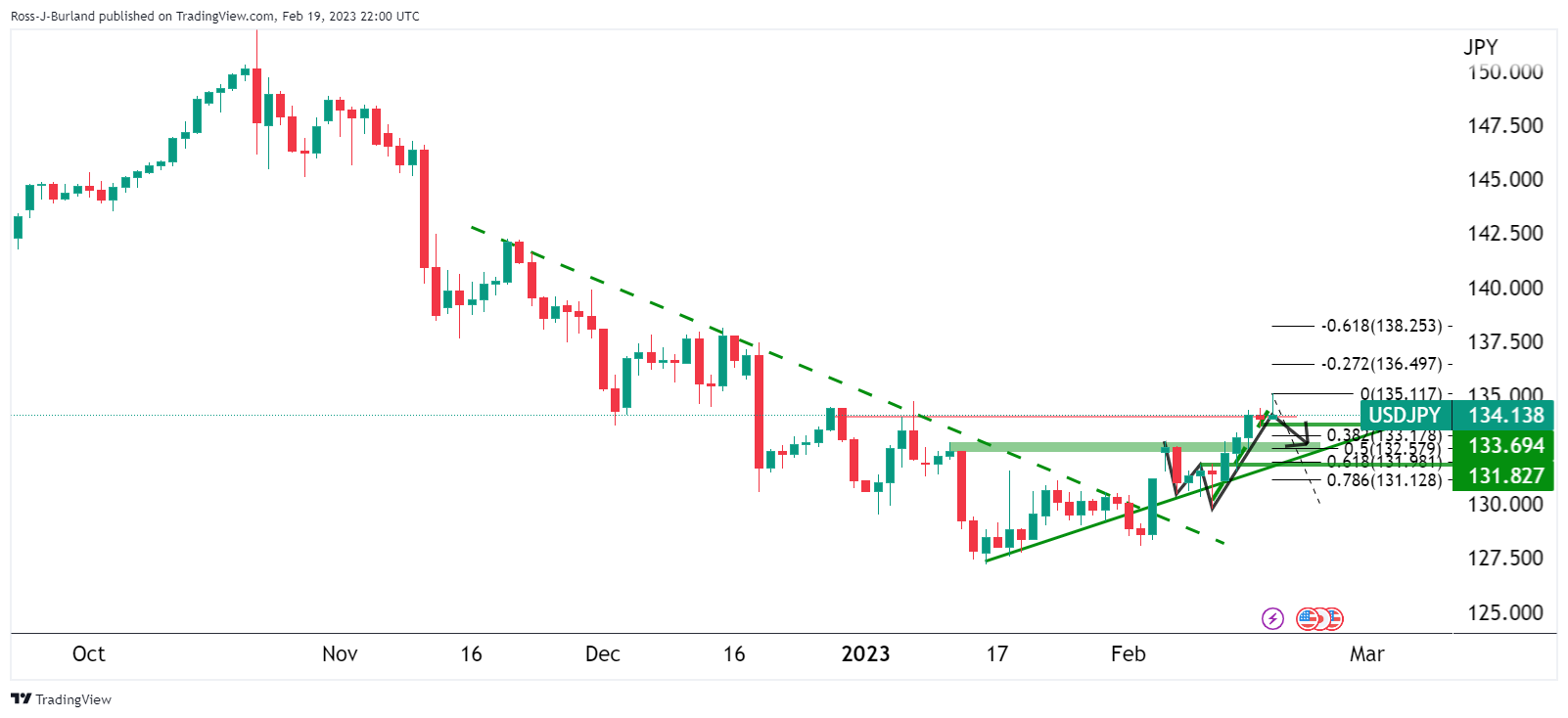
The W-formation is a reversion pattern and in this particular case, we have seen solid resistance at a round number and ongoing pressures into 134.00:
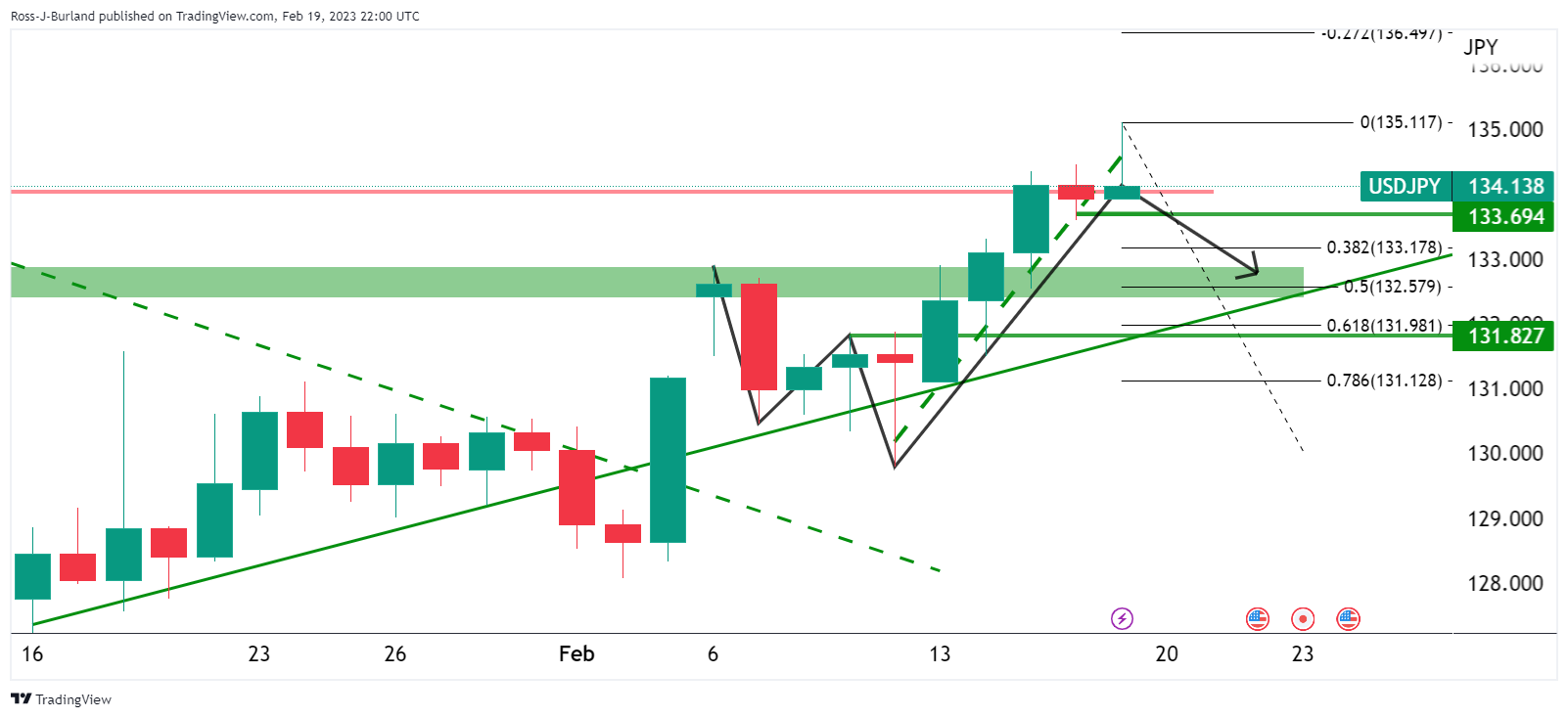
A 50% mean reversion could be in play for the opening range over the coming sessions and the next couple of days to test prior resistance near 132.50. However, while on the front side of the trend, the bias remains broadly with the bulls and should the bulls either commit from here or lower down, a continuation would initially target 135.50/137.20:
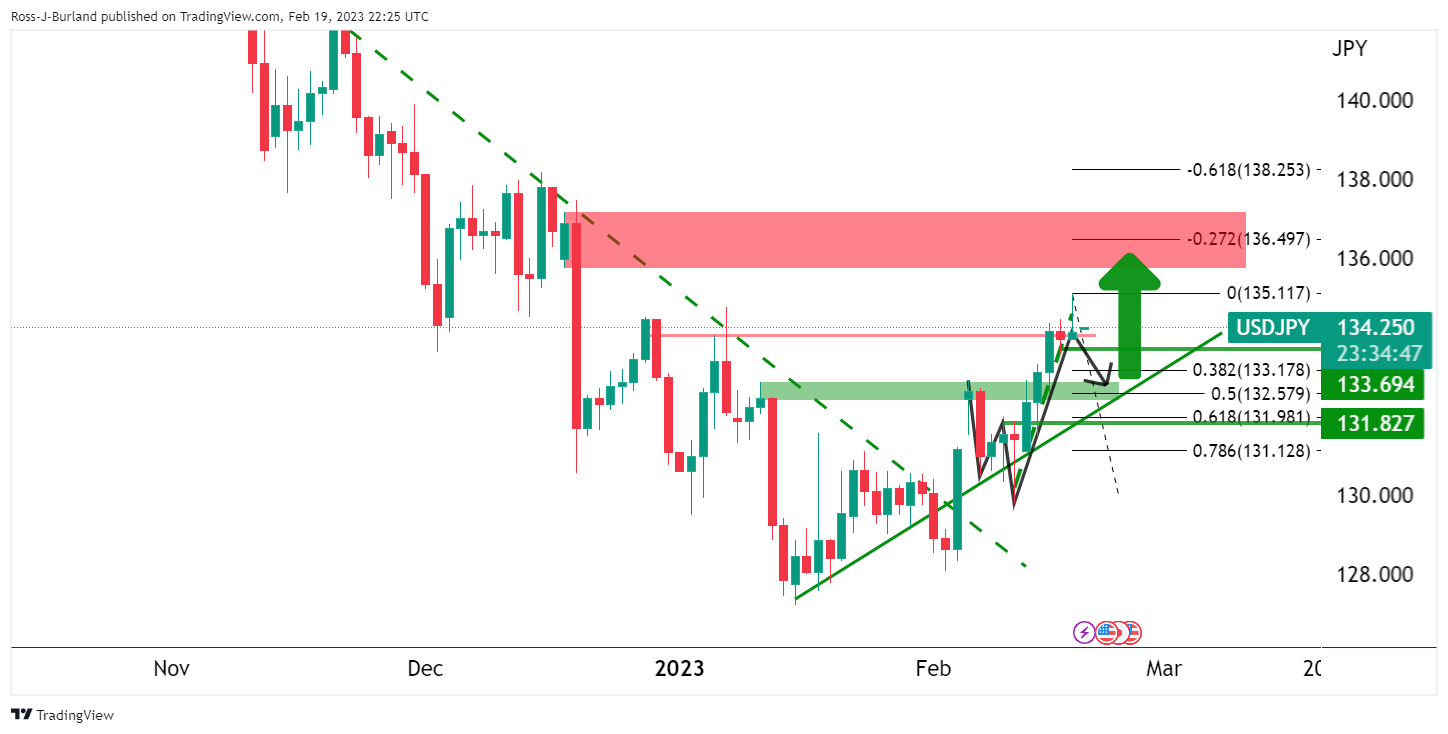
USD/JPY H1 chart
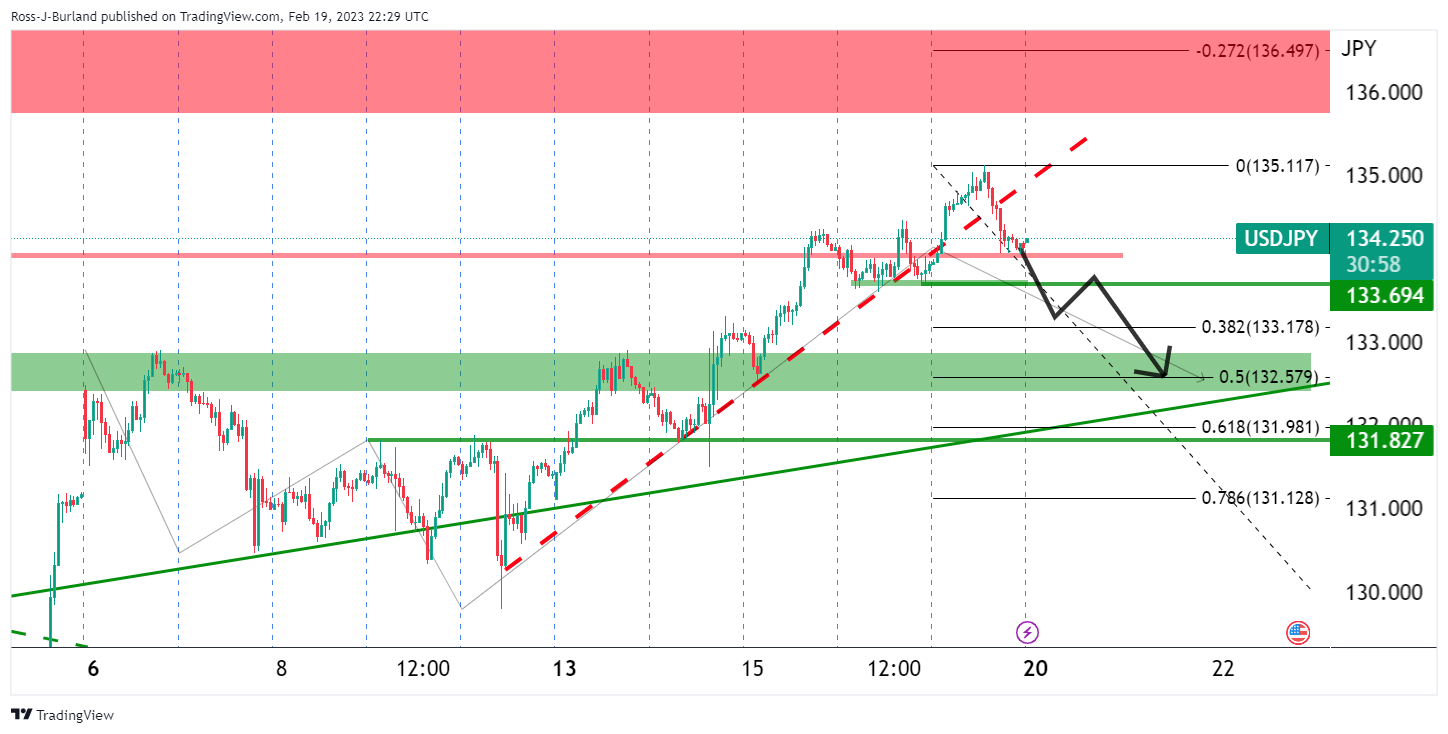
Bears will need to break 133.70 structure which is all that is left to do now that they are on the backside of the hourly bullish trend.
- NZD/USD has slipped to near 0.6320 as the US warning for China on providing support to Russia has dampened the market mood.
- Investors are keenly waiting for the interest rate decision by the PBoC ahead.
- The RBNZ's Shadow Board recommended a 50bps OCR increase citing strong inflationary pressures.
The NZD/USD pair has dropped to near 0.6320 in the opening session on Monday as the market sentiment has got heated. The warning from the US ambassador to the United Nations, Ambassador Linda Thomas-Greenfield, on Sunday that China would cross a “red line” if the country decides to provide lethal military aid to Russia for its invasion of Ukraine, is turning investors risk averse.
S&P500 ended the week with some losses as investors are worried about the economic recovery in the United States after higher-than-anticipated US inflation indicators. And, now the geopolitical tensions could dampen the market mood further. Investors should be aware that the US markets will be closed on Monday on account of Presidents Day.
The US Dollar Index (DXY) displayed a sheer sell-off on Friday as investors shrugged off concerns about a revival in the US inflation concerns. The release of the higher-than-projected US CPI data was followed by higher Producer Price Index (PPI) and Retail Sales data. The annual wholesale inflation scaled to 6.0% versus the consensus of 5.4%. Meanwhile, monthly Retail Sales data climbed to 3.0% against the former release of 1.8%, which cleared that consumer spending is recovering firmly.
On Monday, investors will keep eye on the release of the interest rate decision by the People’s Bank of China (PBoC). A Reuters poll published on February 17 showed that 8 out of 10 economists expect the PBoC to leave the Loan Prime Rate (LPR) unchanged at 3.65%. It is worth noting that New Zealand is one of the leading trading partners of China and an unchanged interest rate policy will result in more business for New Zealand and more support for the New Zealand Dollar.
This week, the release of the interest rate decision by the Reserve Bank of New Zealand (RBNZ) will be the key event. The RBNZ's Shadow Board recommended a 50bps Official Cash Rate (OCR) increase this morning citing strong inflationary pressures.
- Gold price bounces off 10-week-old horizontal support but braces for the first monthly loss in four.
- Fears of higher Federal Reserve rates, no rate cuts in 2023 underpin US Dollar and weigh on XAU/USD.
- Geopolitical concerns add strength to the Gold price weakness.
- Monday’s holiday in the United States, Canada may offer a soft start to the key week, FOMC Minutes will be eyed closely.
Gold price (XAU/USD) stays defensive around $1,842, after bouncing off multi-day-old horizontal support the previous day. In doing so, the yellow metal portrays the XAU/USD traders’ cautious mood ahead of this week’s bumper data and events. Adding strength to the metal’s inaction could be the United States and Canadian holidays on Monday. Even so, hawkish bets on the Federal Reserve (Fed) and firmer US data keep the Gold sellers hopeful of witnessing further downside should the scheduled catalysts favor the bears.
Gold bears cheer upbeat United States data, Federal Reserve talks
With the firmer prints of the United States Consumer Price Index (CPI) and Retail Sales following the previously flashed upbeat readings of employment and output data, the odds of the US economy witnessing easy inflation appear far from here. The same joins hawkish Federal Reserve comments to underpin the firmer US Treasury bond yields and the US Dollar to exert downside pressure on the Gold price.
In the last week, the US Consumer Price Index (CPI) rose past market expectations to 6.4% YoY, versus 6.2% forecast and 6.5% prior. More importantly, CPI ex Food & Energy, better known as the Core CPI, grew 5.6% YoY compared to 5.5% market forecasts and the 5.7% previous readings.
Following that, US Retail Sales growth jumped to 3.0% YoY in January versus 1.8% expected and -1.1% prior. Further, The Retail Sales ex-Autos grew by 2.3% in the same period, compared to analysts' estimate of +0.8%.
As per the latest Federal Reserve (Fed) talks, Fed Governor Michelle Bowman said on Friday that they are seeing a lot of inconsistent data in economic conditions, as reported by Reuters. On the contrary, Richmond Fed President Thomas Barkin said on Friday that they are seeing some progress on inflation with demand normalizing, as reported by Reuters. It should be noted that Fed Chairman Jerome Powell and others at the Fed have strongly favored an absence of rate cuts in 2023, which in turn backed the higher Fed rates and risk-off mood, which in turn propelled the US Treasury bond yield and the US Dollar, ultimately weighing on the Gold price.
Amid these plays, the US 10-year Treasury bond yields rose to the highest levels since early November while the equity benchmarks were mostly in the red. That said, the US Dollar Index (DXY) marked the third consecutive weekly gain.
Geopolitics also challenges XAU/USD bulls
Apart from the aforementioned catalysts surrounding the data and the Federal Reserve talks, the headlines surrounding China and Russia also weigh on the sentiment and exert downside pressure on the Gold price. Recently, The US ambassador to the United Nations, Ambassador Linda Thomas-Greenfield, said Sunday that China would cross a “red line” if the country decided to provide lethal military aid to Russia for its invasion of Ukraine, per Reuters. The news joins the US-China tension about Taiwan and the geopolitical tension among the world’s top two economies to favor the Gold bears.
It should be observed that the latest meeting between US Secretary of State Antony Blinked and China top diplomat Wang Yi seemed to fail in restoring the US-China ties. The reason could be linked to Chinese diplomat’s comments saying that the US must change course and repair the damage done to Sino-US ties by indiscriminate use of force.
Fed Minutes, US GDP eyed
Monday’s holiday in the US joins a light calendar elsewhere to offer a sluggish start to the key week comprising monetary policy meeting minutes by the Federal Reserve (Fed), up for publishing on Tuesday. Also important to watch will be the second reading of the US fourth quarter (Q4) Gross Domestic Product. That said, the market players will be more interested in hearing the clues on how low the rate trajectory can last. Also important will be the confirmation of the upbeat flash GDP, which in turn could weigh on the Gold price.
Gold price technical analysis
A horizontal support area stretched from December 20, 2022, challenges the Gold bears around $1,820. Adding strength to the recovery hopes is the metal’s upside break of a three-week-old descending trend line.
However, the metal’s sustained trading below the 50-Day Moving Average (DMA), as well as the previous support line from late November 2022, keeps the sellers hopeful. On the same line are the bearish signals from the Moving Average Convergence and Divergence (MACD) index, as well as the downbeat Relative Strength Index (RSI) line, placed at 14.
That said, the quote’s latest rebound needs validation from the 50-DMA and the support-turned-resistance line, respectively near $1,860 and $1,910, to convince buyers.
Following that, the monthly high of $1,960 and late March 2022 peak surrounding $1,966 could lure the Gold buyers.
Alternatively, a downside break of the aforementioned horizontal support, around $1,820 can trigger a fresh south run towards November 2022 high near $1,786.
In a case where the Gold price remains weak past $1,786, the odds of witnessing a slump toward the last November’s low near $1,721 can’t be ruled out.
Overall, the Gold price remains indecisive as bears have recently been challenged. However, XAU/USD bulls have a tough road to retake control.
Gold price: Daily chart
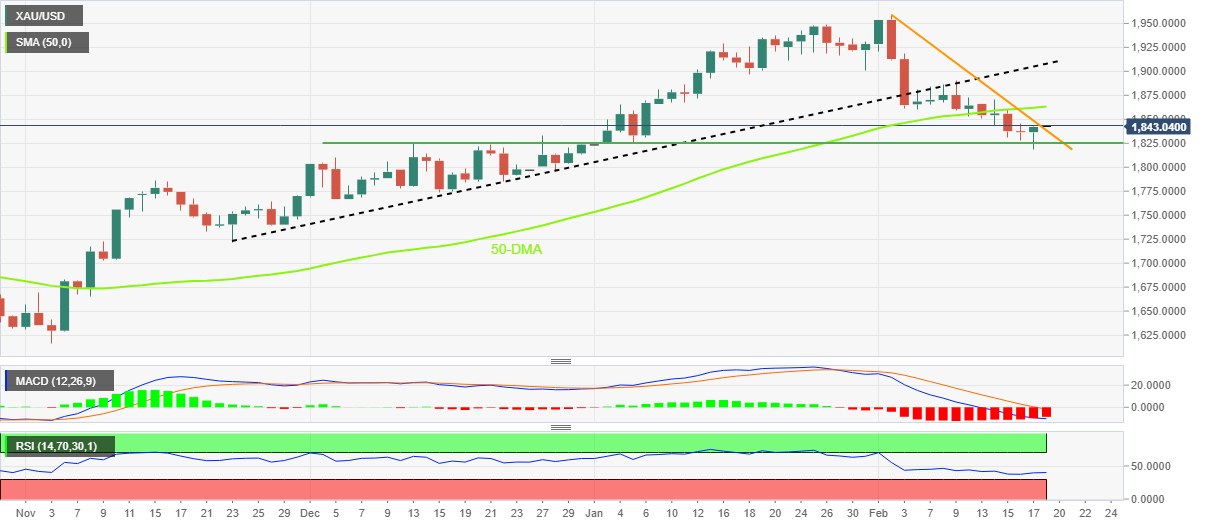
Trend: Further downside expected
- AUD/USD is marching towards 0.6900 as investors have ignored signs of recovery in the US Inflation.
- The US has warned China if it decides to provide lethal military aid to Russia for its invasion of Ukraine.
- Weaker Australian employment data might trim overall consumer spending ahead.
The AUD/USD pair is struggling to extend its upside move above the immediate resistance of 0.6880 in the early Tokyo session. The upside bias for the Aussie asset is still favored as the risk profile is still solid. The major is expected to continue its upside to near the round-level resistance of 0.6900 despite renewed concerns of a rebound in the United States inflation.
S&P500 futures witnessed some losses on Friday and ended the week with mild losses as fresh concerns about a rebound in the US Consumer Price Index (CPI) raised red flags for economic recovery. The odds are favoring the continuation of policy tightening by the Federal Reserve (Fed) as the battle against stubborn inflation is getting complicated. The trading activity is expected to remain light as the US markets are closed on Monday because of President’s Day.
The US ambassador to the United Nations, Ambassador Linda Thomas-Greenfield, said Sunday that China would cross a “red line” if the country decided to provide lethal military aid to Russia for its invasion of Ukraine. This might impact the market sentiment ahead and risk-perceived currencies could face the heat.
Meanwhile, the US Dollar Index (DXY) is looking for a cushion around 103.50 after a perpendicular downside move. The USD Index could show some recovery as higher-than-anticipated US CPI, Producer Price Index (PPI), and Retail Sales data have cleared that consumer spending is getting traction again, bolstering the chance of more rate hikes by Fed chair Jerome Powell ahead.
On the Australian front, weaker employment data will delight the Reserve Bank of Australia (RBA) as consumer spending could drop ahead. The economy has reported an overall lay-off in the labor market by 11.5K vs. the consensus of 20K addition of employees. While the Unemployment Rate is seen higher at 3.7% vs. the prior release and the expectations of 3.5%.
Wednesday's Reserve Bank of New Zealand meeting headlines the week and OIS markets have 45bps of tightening priced into the meeting, and the terminal rate of 5.3%.
The RBNZ's Shadow Board recommended a 50bps OCR increase this morning citing strong inflationary pressures.
Although local analysts still overwhelmingly anticipate a 50bp hike, the market is pricing in a small chance of a lesser move due to the devastation wrought by Cyclone Gabrielle. ''That’s fair,'' analysts at ANZ Bank said. ''It certainly can’t be ruled out. But in our view, monetary policy is not the right tool for the job, and could do more harm than good,'' they analysts argued who say ''NZD will be hypersensitive to the RBNZ’s decision and tone.''
- EUR/USD bears move in and force a failed breakout scenario for the open.
- Meanwhile, a bearish correction could be on the cards for this week's initial balance.
EUR/USD ended Friday near 1.0700 and in a resistance zone after breaking up through the prior week's lows, pulling in breakout traders through 1.0680 and trendline resistance the following pre-open analysis will illustrate:
EUR/USD H1 chart
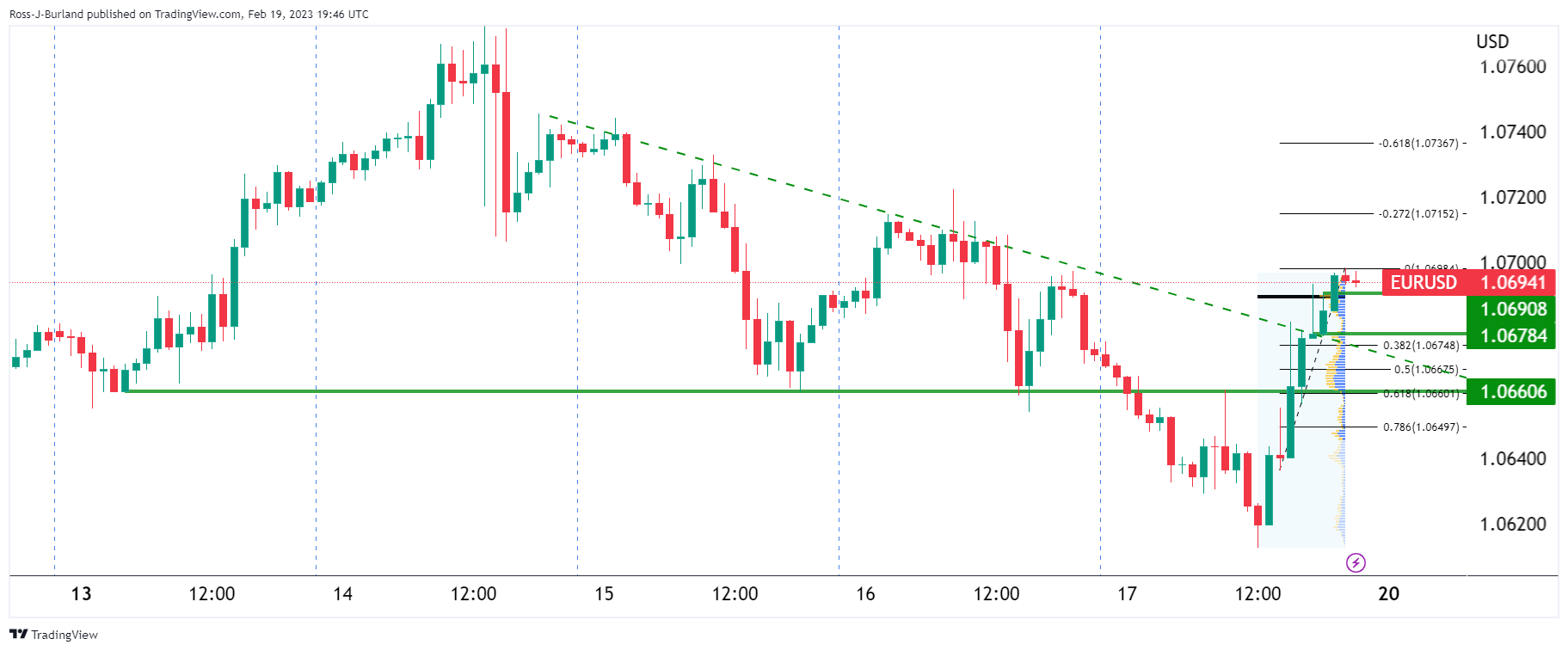
Zoomed in ...
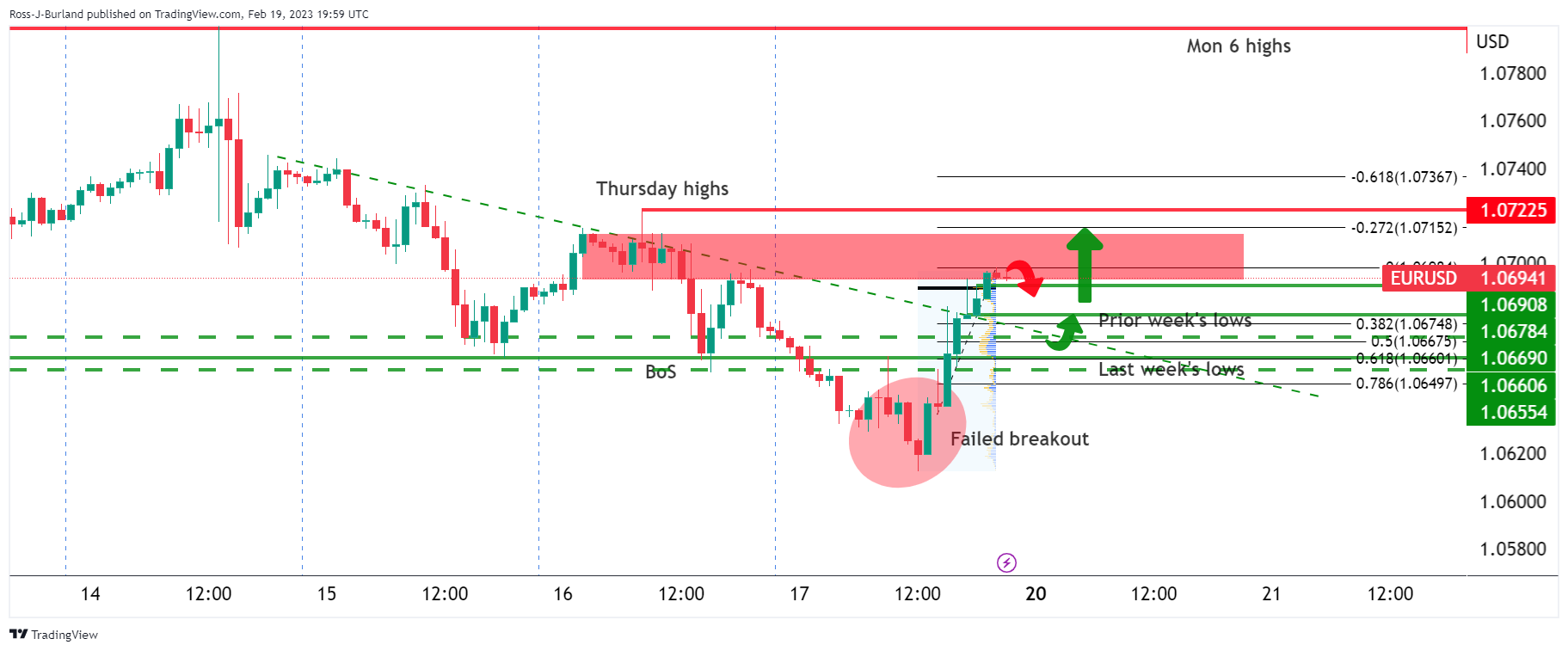
Here we can see that the bulls came up into the prior resistance structure but faced supply into the close on Friday a touch below 1.07 the figure. While a move-up is a possibility in the Asian session today, the price is entering correction territory.
Considering the failed breakout, however, the bias is still to the upside although a move into the prior week's lows and a restest of what would now be considered as a countertrend could be in order.
DXY H1 chart
The US Dollar, as measured by the DXY index came crashing back down to earth on Friday and could also be due for a correction from what might be considered a support zone as illustrated above and zoomed in below:
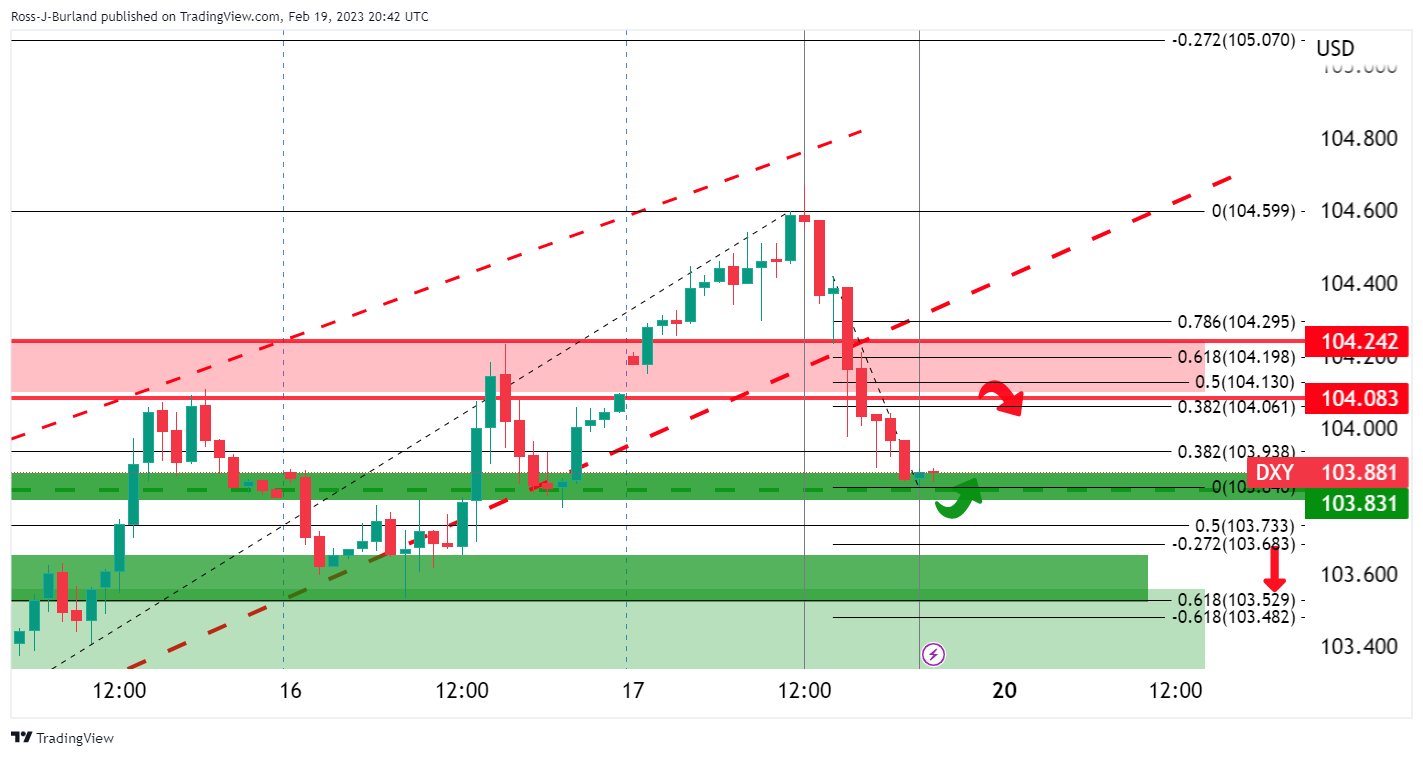
The US ambassador to the United Nations, Ambassador Linda Thomas-Greenfield, said Sunday that China would cross a “red line” if the country decided to provide lethal military aid to Russia for its invasion of Ukraine.
“We welcome the Chinese announcement that they want peace because that’s what we always want to pursue in situations like this. But we also have to be clear that if there are any thoughts and efforts by the Chinese and others to provide lethal support to the Russians in their brutal attack against Ukraine, that is unacceptable,” she told CNN’s Pamela Brown on “State of the Union.”
“That would be a red line,” she warned.
With confirmation from US officials familiar with the intelligence, CNN reported prior that ''the US has begun seeing “disturbing” trendlines in China’s support for Russia’s military, and there are signs that Beijing wants to “creep up to the line” of providing lethal military aid to Russia without getting caught.''
Meanwhile, Western leaders have reacted nervously to a Chinese peace plan for Ukraine due to be revealed this week.
China’s senior diplomat Wang Yi spoke at the Munich Security Conference and announced that China would launch its peace initiative and has already been consulting Germany, Italy and France on its proposals but at the same time, he also said the legitimate security interests of Russia needed to be respected.
Secretary of State Antony Blinkenis was also in Germany for the Munich Security Conference and he spoke face-to-face with Wang on the consequences China would face if they were to provide weapons, ammunition, or other lethal aid to Russia.
© 2000-2024. All rights reserved.
This site is managed by Teletrade D.J. LLC 2351 LLC 2022 (Euro House, Richmond Hill Road, Kingstown, VC0100, St. Vincent and the Grenadines).
The information on this website is for informational purposes only and does not constitute any investment advice.
The company does not serve or provide services to customers who are residents of the US, Canada, Iran, The Democratic People's Republic of Korea, Yemen and FATF blacklisted countries.
Making transactions on financial markets with marginal financial instruments opens up wide possibilities and allows investors who are willing to take risks to earn high profits, carrying a potentially high risk of losses at the same time. Therefore you should responsibly approach the issue of choosing the appropriate investment strategy, taking the available resources into account, before starting trading.
Use of the information: full or partial use of materials from this website must always be referenced to TeleTrade as the source of information. Use of the materials on the Internet must be accompanied by a hyperlink to teletrade.org. Automatic import of materials and information from this website is prohibited.
Please contact our PR department if you have any questions or need assistance at pr@teletrade.global.
